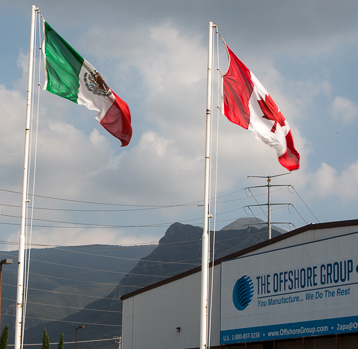Weighing the benefits of offshoring versus reshoring is not new, but these discussions have become more frequent for many companies experiencing more frequent global supply chain disruptions in recent years. From the havoc wreaked by the COVID-19 pandemic to tariffs and more, many manufacturers are weighing the pros and cons of making a change in a manufacturing location.
Return on Investment (ROI), a global authority on investment attraction for economic development organizations, writes in its new book Understanding the Reshore Seesaw that the pandemic has served as a catalyst accelerating the process of transforming global supply chains. To help organizations determine whether now is the time to take action, ROI dives into the discussion by explaining the challenges holding some organizations back—and the opportunities available by considering nearshoring instead.
What is reshoring?
ROI notes that one of the challenges in understanding reshoring comes from the fact that it’s often loosely defined. Reshoring is actually the practice of moving business operations that had been previously moved overseas back to the country where it was originally located. Investing in a new domestic facility is not “reshoring” if the company maintains its overseas presence.
What’s more, many companies find that nearshoring is a much more cost-competitive alternative to reshoring. By nearshoring—or moving manufacturing geographically closer to the home country where goods will be sold—companies can reduce shipping time and costs and still gain benefits of low-cost manufacturing.
Other alternatives to reshoring include what ROI calls “redundancy, not reshoring” and “China plus one” strategies, in which companies diversify their global footprint. Many global organizations benefit by retaining an offshore presence to serve that local market and adding more regional manufacturing operations. Not only does this capitalize on shipping cost savings, but it also provides some stability for reacting to a regional supply chain disruption.
Addressing the challenges of reshoring

While there are significant benefits to moving or adding manufacturing operations closer to home, the hurdles tend to stop many manufacturers from moving forward. As ROI points out, relocating a manufacturing facility is a complex, time-consuming, and expensive exercise.
By understanding the strategic considerations to untangle in advance, organizations can determine whether or not the cost savings outweigh the risks for their particular move. According to ROI, these challenges include:
- Relocation costs. Moving a manufacturing operation is expensive; there’s no way around it. But it’s the long-term cost savings that drive companies to offshore and should drive any decision to move manufacture closer to the countries where your product will be sold. It’s important to develop a cost analysis that accounts for all potential costs and the long-term cost savings of making a move.
- Protecting your IP. Moving your operations out of a country leaves the risk of leaving behind the intellectual property that former employees can take to market under a new brand. That risk, however, should factor in companies’ decision to offshore in the first place. Moving to a country with IP protections in place and a commitment to evolving IP protections should be a priority for innovators.
- Time. Planning and delivering a new manufacturing site can take several years to complete. However, not all companies start with a greenfield development. By working with a full-service shelter service provider in Mexico, many manufacturers can move into a Class A industrial space, recruit a skilled workforce, and be ready for operations within 90 days.
- Manufacturing know-how. As manufacturing has moved into low-cost countries, the United States and other countries have seen a decline in corresponding manufacturing skills. Coupled with labor shortages, and it can be difficult for companies to find the labor to man reshored facilities. By turning to places like Mexico, with strong demographic advantages and an extensive network of technical trade institutes, companies are better able to fill their technical positions with skilled laborers.
- Environmental issues. As ROI points out, making a product in China before flying it more than 8,000 miles to customers in the U.S. is becoming increasingly questioned. Global supply chains have a tremendous environmental impact, and climate change concerns have been an important consideration in corporate location planning. Taking a more regional approach to manufacturing can reduce the environmental impact of shipping.
- Capabilities and sophistication. Offshoring has been a part of business for decades, and that’s driven the creation of massive manufacturing ecosystems in China. Companies looking to move to lower-cost countries such as Vietnam or Thailand will find those locations to still be in the early stages of developing those ecosystems. Mexico, however, has been a manufacturing powerhouse for decades. It has sophisticated industrial clusters across several industries, including automotive, aerospace, electronics, and medical device manufacturing.
Who is reshoring to Mexico?
The Institute for Supply Management’s July 2020 survey of 676 U.S. manufacturers on the COVID-19 pandemic’s impact on supply chains found 24% of survey respondents were considering reshoring or nearshoring some if not most of their operations. A September 2020 report from the American Chamber of Commerce in Shanghai of more than 200 respondents that own or outsource manufacturing operations in China found 14% to be moving some production from China to non-U.S. locations.
These numbers don’t reflect the fact that many manufacturers have already made a similar move. After all, the COIVD-19 pandemic is just the latest in a long line of global supply chain disruptions that have made manufacturing decision-makers familiar with the concepts of reshoring and nearshoring. Now, with the USMCA trade agreement in effect, those manufacturers are more likely to see Mexico as a strong, stable alternative location.
As Mexican undersecretary for foreign trade Luz Maria de La Mora put it, “What USMCA gives us today is the opportunity for the shortening of value chains in North America, where Mexico could become a very important place.”
Of course, companies that make a move today gain the benefit of a stronger position for the next disruption.
If you’re ready to make a move toward a stronger manufacturing future, we’re ready to help. Contact Tetakawi today and start planning your expansion into Mexico.
Below this text, you will find a recording of our webinar, "Should you manufacture in Mexico?":
Subscribe
Sign up and stay informed with tips, updates, and best practices for manufacturing in Mexico.





